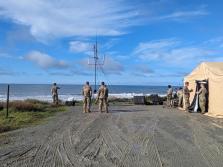Army used pair of concurrent exercises to test distributed command and control nodes

For the first time in over 40 years, the Army concurrently ran its keystone Warfighter Exercise with Yama Sakura in Japan, allowing it to test distributed command and control nodes and conduct operations over noncontiguous locations.
“We were able to exercise the Corps and our subordinate divisions to conduct large-scale combat operations in the fictional locations that we had,” Lt. Gen. Matthew McFarlane, commander of I Corps, said in a call with reporters Thursday. “Non-contiguous outside of Japan, extending the area of operations to really test what the Corps needs to be able to do in the fight, which includes the key ones the Corps are driving: the communications, the sustainment, the logistics, getting the logistics to the different islands in the Pacific environment, the protection across all of those locations, as well as the long-range fires, intel sensors and gathering information so we can operate and then also we can share that with our multinational partners that we’re operating with.”
Yama Sakura, which took place Dec. 7, is an annual command post exercise focused on the defense of Japan. This year, it included the U.S. and Australia. The Warfighter Exercise is the premier corps and division-level command post engagement to train forces on mission command concepts and capabilities.
Bringing the Warfighter to run concurrently with Yama Sakura allowed the Army to set up its distributed command and control nodes and replicate and extend the lines of communication between mission command nodes while allowing I Corps to conduct operations across noncontiguous locations outside of Japan, from a Yama Sakura perspective.
The concurrent and simultaneous efforts allow the Army to test new concepts for itself while working to integrate and pass data with international partners.
The concurrent exercises informed “how we organize within our mission command cells or our command posts and the tools we have across our network, if you will, to make sure we can do it quickly, and we can pass live data quickly without having to use, for instance, swivel chairs or data liaison detachments, but our systems can connect and we can integrate and leverage technology to help us fight at the speed of war,” McFarlane said.
Both events sought to inject real and simulated capabilities, taking lessons from the conflict in Ukraine to ensure forces are staying up to date with the latest battlefield advances. That included electronic warfare, unmanned aerial systems and other unspecified “multidomain” capabilities.
“We did integrate a large amount of what we’re seeing in the Ukraine and other places into this to make sure we’re ready. We did experiment with quite a few things as we looked at our ability to ensure we could mitigate effects from threat systems and optimize our capabilities to enable the subordinate divisions we had,” McFarlane said. “As we do these trilateral exercises, we continue to focus and build our ability to pass information, to address the different threats that are out there and optimize our capability from the Multidomain Task Force, the EW capabilities inherent into what we have in the Corps.”
Moreover, I Corps sought to experiment with how to integrate new formations, capabilities and concepts within current structures.
That included introducing UAS, which was tested with 2nd Brigade, 25th Infantry Division, one of the first three so-called transforming-in-contact units. Transforming-in-contact is an ongoing effort within the Army that uses deployments and troop rotations to test new equipment and concepts — mainly commercial off-the-shelf gear that currently focuses on unmanned aerial systems, counter-UAS and electronic warfare — that could allow units to be more responsive on a dynamic battlefield.
McFarlane stated the I Corps wanted to see what those capabilities look like when moved up to the division level to better understand how to optimize those new capabilities as they look at employing them.
The exercise also established a multidomain effects cell within the main division command post to ensure forces could plan and integrate, over time, the effects and optimize where those effects were going to enable outcomes.
“The multidomain effect cell was, I think, the biggest one we did as the convergence happens at the corps level, with our doctrine. With the Multidomain Task Forces working at the theater level, how do we integrate their effects, how do we integrate space, cyber,” McFarlane said. “It extended our operational reach, if you will, as we also work to ensure, as we work with partner countries, that we could help them benefit from the effects the Multidomain Task Forces bring to the fight.”






